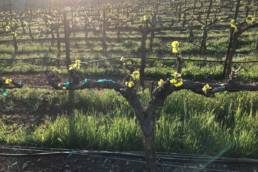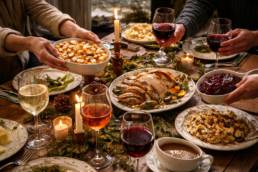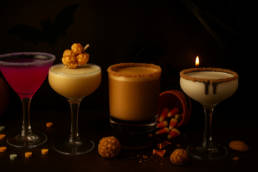FMN – July 2020 – Red, White and Bourbon
This article was never meant to be political and I work hard to keep it that way. I strive for a pleasant distraction to the craziness of our lives and the world around us. I am, however, continually proud to be an American and take my patriotism quite seriously. Therefore to celebrate our forefathers declaring themselves a free nation, I plan on doing my civil duty of grilling, watching fireworks and imbibing on “patriotic” adult beverages. Let’s call it my red, white and Bourbon day.
White, symbolizing purity and innocence, seems like a logical place to begin; as we are talking about the flag and the wine with author exclusion. Hopefully my celebrations will commence around midday with some local Carolina saltwater bounty. Any accompanying wine would need to have similar historical revelry as our state seafood industry so I went with a historical classic, Rombauer.
Koerner and Joan Rombauer moved to Napa in 1972, as Koerner’s primary career was a pilot, first for the California Air National Guard followed by a commercial airline. With his ancestors hailing from the German wine region of Rheingau and his great aunt Irma Rombauer authoring the internationally famous cookbook, The Joy of Cooking, Koerner had a passion for food and wine.
Their first stint in the business came as a partnership in Conn Creek Winery and after only a few years sold their stake and opened Rombauer Vineyards in 1980. While the winery and custom crush facility were being built, the first few vintages were vinified at Staggs Leap and in Koerner’s garage; that he had bonded as a winery for just that purpose.
Through the years they have expanded their vineyard holdings and have increased their portfolio of wines. With Joan passing away in 2002 from pancreatic cancer and Koerner passing in 2018 the helm has been passed to the third generation of family. Even today, forty years later, the family continues to grow the legacy by their striving to be better stewards of their land through sustainability. From water conservation, fish friendly practices and solar power accounting for 70% of their usage, Rombauer Vineyards moves forward with their foundation firmly planted in proud family heritage.
As the day progresses and we look to throw something that had parents on our now glowing grill, we switch to the ‘hardiness and valor’ of our red stripes. Although many different grapes were grown long before the success of California wines, the initial grape that catapulted America onto the international wine radar was Cabernet Sauvignon.
Although Nick Goldschmidt hails from New Zealand, he truly is a student of the world when it comes to making wine. Getting his formal education in both New Zealand and Australia, he then went on to make wine in New Zealand, Australia, South America and California; finally settling on Healdsburg in Sonoma as his home.
He started at Simi Winery in 1990 as associate winemaker under the well-known Zelma Long and Paul Hobbs and later took the helm as head winemaker for over a decade. Nick wore many hats through his career, including head winemaker for Allied Domecq and Beam Estates, owner of an importation company, vineyard owner, consulting for dozens of wineries in seven different countries and creator of multiple brands under the Goldschmidt Vineyards umbrella.
Believing in terroir driven, site-specific wines that express their sense of place, Goldschmidt’s many brands are proof this mantra. One such label, Trig Point pays homage to his father who worked as a surveyor at the South Pole. The reds under this brand (Cabernet Sauvignon, Merlot and Zinfandel) are all grown in Alexander Valley and Goldschmidt has a love of red grapes grown here. Due to a slightly cooler growing environment compared to Napa, the resulting wines have lower alcohol and increased elegance.
As day gives way to evening and impending mortar-like explosions followed by trips to the ER, I will sit back with my true American drink, Bourbon. Every Bourbon drinker has their favorite label, proof and way to consume. In this way, bourbon becomes a very personalized experience for each individual consumer. I’m not here to change your mind or the way you drink this piece of history. I do however, want you to explore the history of the Old Forester Brand and how it changed the way we all drink Bourbon today.
Founder, George Garvin Brown, was a pharmaceutical salesman in Louisville, Kentucky and started the distillery with his half-brother. The distillery was named after Dr. Forrester, a long-time friend that endorsed Brown’s concept of bottled medicinal whiskey. At the time, Brown was purchasing whiskey from three nearby distilleries: Mattingly, Mellwood, and Atherton and blended them. Brown sealed the whiskey in glass bottle and signed each one to prove their authenticity, creating the first bottled bourbon in 1870.
In 1897 the Bottled in Bond Act was passed and specified that the whiskey be bottled at 100 proof and from one distillery during one distilling season, so Mr. Brown purchased the Mattingly distillery in 1901; changing from a whiskey blender to a true distiller. A fire on the bottling line, in 1910, shut down production and the whiskey that had been dumped from the barrels in preparation for bottling had to be put back in barrels to await repairs to the bottling line. The resulting whiskey was sold as “Very Old Fine Whiskey”, the industry’s first double-barreled bourbon.
Under the guise of “medicinal,” Brown was able to get a license to continue whiskey production during Prohibition, one of only six issued licenses. Therefore, Old Forester remains the only bourbon that was continually sold by the same company before, during and after Prohibition. Other firsts include the first single-barrel bourbon in 1961, President’s Choice and the first vintage dated bourbon, Birthday Bourbon, 2002.
Now on the fifth generation Brown family, Old Forester continues to be an industry leader; not by flashy advertising tactics but rather by staying true to the heritage and reaching into the past, breathing new life into traditional styles of whiskey.
With our bellies full of patriotism (and a lot of food and drink), we can attempt to get some well-deserved rest during those colorful explosions. I hope you sample some history along with me while celebrating the birth of our great country. Have a happy and safe holiday.
Suggested Wines
Rombauer Vineyards Carneros Chardonnay 2018 Carneros $38
This 100% Chardonnay has aromas of orchard fruit (peach), tropical fruit (mango, tangerine, grilled pineapple) and buttered toast (a testament to primary fermentation in oak). The dry palate has an upfront tart acidity slightly downplayed by the increased viscous mouthfeel (due to malolactic fermentation and lees stirring). Flavors of tropical citrus wrapped in a buttered pie crust emulate on the palate. The finish is slightly warming and finishes with a lingering taste of orange marmalade on freshly buttered hot toast. Pair with citrus marinated shrimp, blackened redfish or grilled salmon.
Trig Point Cabernet Sauvignon Diamond Dust Vineyard 2017 Alexander Valley $26
One first notices the overt aromas of ripe raspberries and with careful inspection and aeration, mint, dill, and a slight caramel element. The palate has a lighter body for a Cabernet Sauvignon and soft fine-grained silty tannins that exemplify its elegance. Flavors of dark baked cherry, baking spice and espresso follow to a clean raspberry and silty coco textured finish. With only 5000 cases produced, this will not last long. Drink this wine with game birds, beef ribs, or tenderloin. This is one I am happy sipping with my quiet contemplations.
Old Forester 86 Proof Bourbon Louisville, Kentucky $23
The nose has elements of sweet corn, mint, tobacco, vanilla, and cola nut. The mouth-coating palate has the alcohol well in check and flavors of spice (from rye), vanilla, baked sweet corn and orange peel. The finish is slightly drying and pleasantly dusty. Although I usually consume my whiskey with my journey toward self-actualization, it does pair rather well with grilled foods, pork barbecue, and chocolate.




